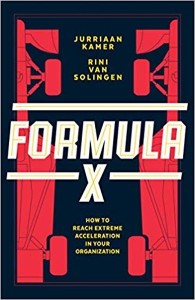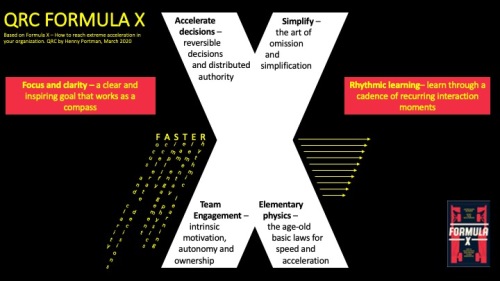 Jurriaan Kamer and Rini van Solingen are the authors of Formula X – How to reach extreme acceleration in your organization? It’s a business fable that shows which steps you should take to drastically accelerate the time-to-market in your own organization.
Jurriaan Kamer and Rini van Solingen are the authors of Formula X – How to reach extreme acceleration in your organization? It’s a business fable that shows which steps you should take to drastically accelerate the time-to-market in your own organization.
In this novel, we follow Ronald Verhulst, the director of a major kitchen manufacturer who is confronted with an advertisement, placed by the major shareholder promising that kitchens can be operational within two weeks from order. If it takes longer, you get the kitchen for free. This sounds disruptive if you know that the current time-to-market is twelve or more weeks. Based on a number of advices from a Formula I team, Ronald shows how to translate these lessons learned into his own organization and to implement them step by step. Do you have any idea how often a Formula I team evaluates the way they operate and how many improvements are being made between two races?
But before Ronald actually gets to work on this advice, he started to work with the Full Control Consulting Group. They helped Ronald to implement Total Efficiency Management with which measurable processes can be accelerated. Completely in line with his own adage “Trust is good, but control is better!” This approach didn’t work, but it took some time to gain that insight. He sends the Consulting Group away and started with the lessons learned from the Formula I team.
 To Download: QRC (Formula X, 200313) v1.0
To Download: QRC (Formula X, 200313) v1.0
From the conversation with the driver and the team boss of the Formula I team, Ronald manages to distil six lessons (the authors call this the FASTER model consisting of six parts, the initial letters together form the word “FASTER”):
- Focus and clarity – a clear and inspiring goal that works as a compass
- Accelerate decisions – reversible decisions and distributed authority
- Simplify – the art of omission and simplification
- Team Engagement – intrinsic motivation, autonomy and ownership
- Elementary physics – the age-old basic laws for speed and acceleration
- Rhythmic learning– learn through a cadence of recurring interaction moments
In the book we get the translation of all these lessons to the kitchen manufacturer and we see the effect but also the struggle to win the organization for taking these steps. In the beginning we see a silo organization in which every department in itself works efficiently, but ultimately it is all about the result of all steps together. By learning on the basis of the aforementioned lessons and making changes based on them, the lead time is improved step by step. In the end, a final drastic step is taken. The ‘walls’ between the departments such as sales, planning, purchasing, production, installment and customer contact are broken down. Multidisciplinary teams are created that are responsible from the first customer contact to the final delivery of a kitchen. It may be clear where it ultimately leads. There are now teams that are able to install kitchens very quickly in a fixed cadence, with a lot of satisfied customers and a happy large shareholder as a result.
Conclusion: The chosen approach in which we learn from a Formula I team and apply it to a kitchen manufacturer shows that you can do a lot in a non-IT company too to improve your organization’s agility and what this means for you in your role as manager ( e.g. letting go and decentralized decision making). Pouring it into a business fable makes it fun and easy to read. Personally, I find the description of the current situation and “improving” through control steps too long. This covers more than half of the book and by shortening that part, the book could have gained in strength. Nevertheless, the book is definitely worth reading and offers plenty food for thought and potential experiences!
While writing this review they came to replace my boiler. A team of 2 mechanics arrived at 8 AM. They were ready around noon. Small problem: the digital thermostat had an error message. No connection with the boiler and therefore no heating! They failed to solve it. A connector between central heating and thermostat turned out to be broken. This happened them quite often when replacing a central heating boiler. However, this energy supplier had a separate team for this. After a 30-minute call, they told me that I would be called back within half an hour. That indeed happened and the team was due to arrive that afternoon between 1 and 5 PM. Around 4 PM another mechanic came with a new connector. Solved in five minutes. Suppose this energy supplier had read this book, they would probably have integrated this thermostat team with the heating installers after evaluating these types of problems. Many phone calls, an extra ride, and the turnaround time at my place would have accelerated by 50% and as a result a cost reduction for the supplier!
A week later I receive a letter for the yearly maintenance of my boiler. This letter still involved maintenance of my old boiler. After a few phone calls, it became clear that the back office had not yet made the changes. Another example of different teams / silos. In the meantime, I have received three more letters about scheduling regular maintenance, so I have to give them a next call and bring this book to the attention.
To order (managementboek): Formula X
To order (Amazon.com): Formula X
How to accelerate decisions:
















Again Henny, a big thanks for this. I have just got the audio and kindle versions.
Pingback: Quick Reference Cards in 2020 | Henny Portman's Blog
Pingback: Overview of my year 2020 book reviews | Henny Portman's Blog